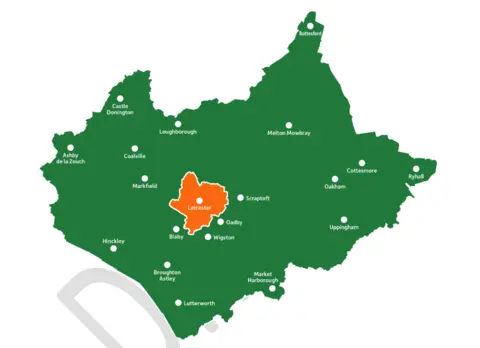Expanding city could save councils £46m, says mayor
The mayor of Leicester believes that expanding the city’s electoral borders might save municipalities £46 million each year in the future.
Sir Peter Soulsby has disclosed the potential scope of public sector efficiency as the Labour-led Leicester City Council finalises plans for a significant shake-up of local government.
The Labour mayor wants a new local political map, with the authority’s limits expanded to include towns and villages now covered by adjacent district councils.
Reform UK, Conservative and Liberal Democrat politicians at Leicestershire County Council, as well as the county’s existing seven districts and boroughs, are all opposed to expanding the city boundaries.
Ministers are asking all existing councils to submit final ideas on their preferred future choices by the end of the month in order to streamline council structures and replace the current two-tier system with new, larger unitary councils.
Soulsby, whose own mayoral position is set to be abolished, said the city proposal would establish two new unitary councils for Leicester, Leicestershire and Rutland, with the city border expanding into neighbouring built-up areas and suburbs such as Blaby, Oadby and Birstall.
He stated that this would save administration expenses and service duplication while also providing the city with space for houses to accommodate its rising population.
The idea would establish a second unitary authority for the county’s rural districts and market towns, which surround the metropolis.
 Leicester City Council
Leicester City Council
The mayor stated, “Regardless of which side of the city and county boundary you live on, the way services are currently delivered is wasteful and confusing.”
“Our proposal would result in balanced population numbers in the city and adjacent county districts. “Modelling demonstrates that this is the best financial decision in the long run for everyone.
“Reorganising the ten existing local councils into two unitary authorities of equivalent size would result in more efficient and cost-effective council services throughout the area, as well as more simplified decision-making.
“An expanded city will also be key to boosting housing and local economic growth and unlocking devolution.”
stated that the city’s existing boundaries was a “historic accident” that limited its growth.
 Leicestershire County Council
Leicestershire County CouncilAccording to the municipal council’s proposal, the population would increase from 372,000 to an anticipated 622,000 by 2028, when the government intends to build new councils.
This would leave 584,000 people in the neighbouring areas. The county council intends to inform ministers that a single council, including Rutland, should surround the city’s current footprint and serve around 800,000 citizens.
It stated it will save around £40 million per year by reducing the number of senior officials and elected members, as well as back-office expenditures.
Reform UK county council leader Dan Harrison stated that the county’s approach would allow the money saved to be invested in front-line services.
He stated, “We have considered resident feedback, and [our] proposal avoids splitting communities or changing city boundaries, which could have an impact on our local heritage.”
“The new unitary authority for Leicestershire and Rutland will ensure that local residents are involved in decisions that affect them.”
“Combining services will reduce duplication, improve co-ordination and provide consistent, high-quality services.” Harrison stated that the measure would also eliminate the possibility of dividing up current social care departments.
 Leicestershire districts & Rutland County Council
Leicestershire districts & Rutland County CouncilWhatever the outcome of the procedure, the county’s districts are scheduled to be dissolved.
They, along with Rutland County Council, indicated they would propose three unitary councils for Leicester, Leicestershire, and Rutland when they present their plans to ministers at the end of November.
Their favoured option is “North, City, South.” A North Leicestershire and Rutland council would cover the territory currently served by Charnwood Borough, North West Leicestershire District, Melton Borough, and Rutland County Council.
A independent South Leicestershire council would include Blaby district, Harborough district, Hinckley and Bosworth boroughs, and Oadby and Wigston borough councils.
The district leaders stated that their plan will result in three equally balanced councils, each serving around 400,000 people, driving economic growth and saving £44 million in efficiency.
Pip Allnatt, leader of Melton Borough Council, who represents the districts and Rutland, stated that the North, City, South plan was developed by the eight partner councils, representing a diverse range of political views and demonstrating a strong commitment to collaboration for the benefit of our communities.
“North, City, South offers a compelling argument for implementing devolution alongside local government reorganisation. “This will spur investment, create jobs, and increase prosperity. The strategy incorporates feedback from businesses and stakeholders who support these goals.
“It also highlights a once-in-a-generation opportunity to change from treating symptoms to addressing fundamental causes, allowing people to receive treatment earlier.
“Local government isn’t broken, but the government says change is needed and the North, City, South plan offers a clear direction of travel for Leicester, Leicestershire and Rutland for the next 50 years.”
Read more on Straightwinfortoday.com


Comments are closed, but trackbacks and pingbacks are open.